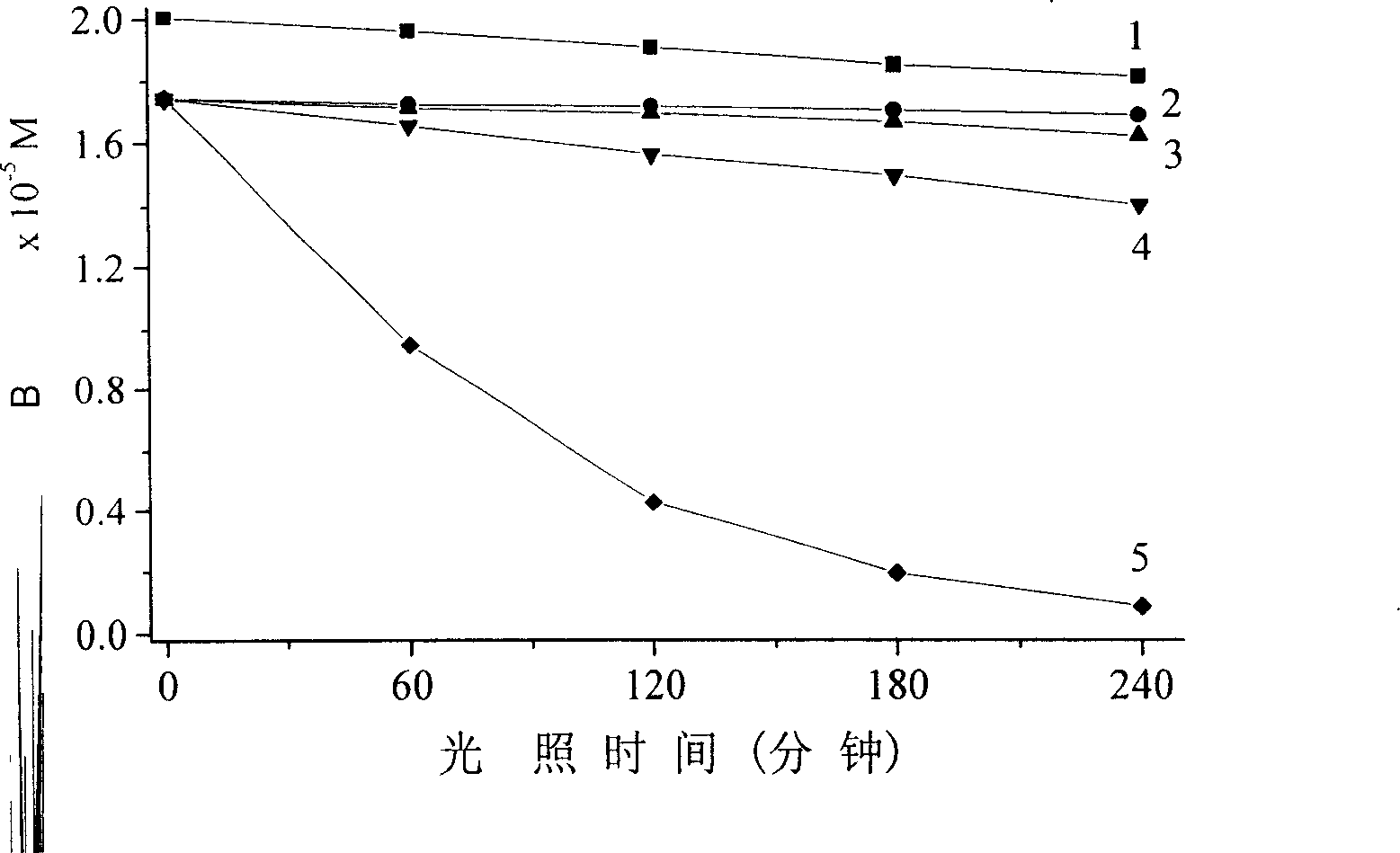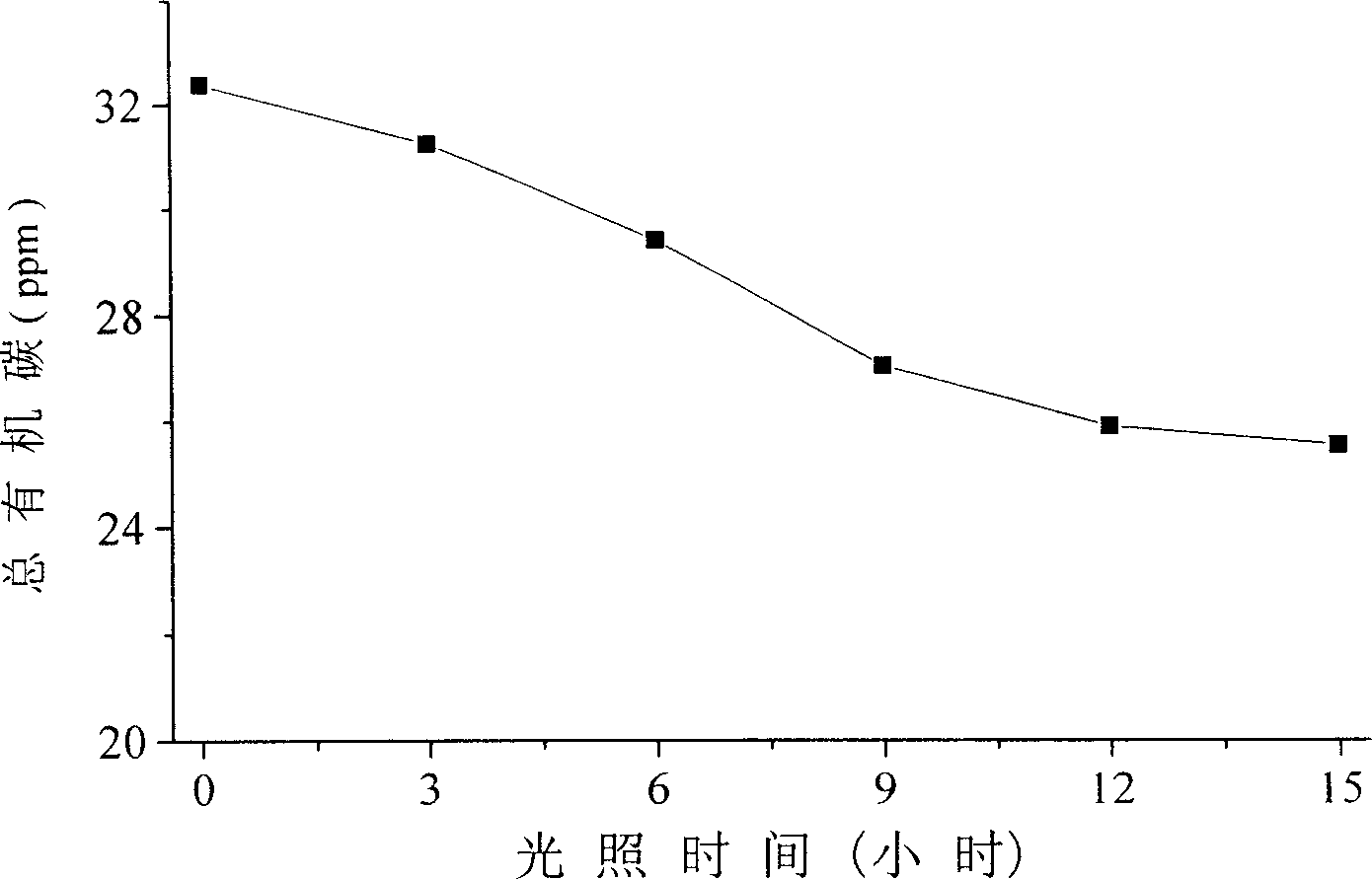Solid-phase photocatalyst utilizing visible light and its preparing method
A photocatalyst and visible light technology, applied in chemical instruments and methods, physical/chemical process catalysts, metal/metal oxide/metal hydroxide catalysts, etc., can solve problems such as high power consumption, reduce operating costs, avoid The effect of secondary pollution
- Summary
- Abstract
- Description
- Claims
- Application Information
AI Technical Summary
Problems solved by technology
Method used
Image
Examples
Embodiment 1
[0048] Get 1.0 g of strong anion-exchange resin (Amberlite IRA 900 type of Aldrich Reagent Company of the United States) with styrene / divinylbenzene having a selected particle size of 0.05 to 0.45 microns as a copolymer, in 50 milliliters of 0.5 M Magnetically stirred in aqueous HCl solution for 30 minutes, filtered, electromagnetically stirred in 50 ml of 0.5 M NaOH aqueous solution for 30 minutes, and washed with 500 ml of deionized water. Filter out the treated resin, add it to a glass container, add 20 ml of deionized water, slowly add 61.2 ml of 1×10 -4 M's phosphomolybdic acid (H 3 PMo 12 o 40 ) aqueous solution, and with 0.1M HClO 4 Adjust the pH to 3.90, and carry out loading bonding under electromagnetic stirring. Stir for 48 hours, then stop stirring. Rinse with deionized water until no phosphomolybdate ions are detected in the solution, then centrifuge, and dry in vacuum at a low temperature of 10°C for 36 hours to obtain a supported catalyst.
Embodiment 2
[0050] Get 1.0 g of polystyrene-type strong anion-exchange resin (Nankai University Chemical Plant, D201 type) with a selected particle size of 0.5 to 1.8 microns, and electromagnetically stir it in 50 milliliters of 0.5 M HCl aqueous solution for 30 Minutes, after filtration, electromagnetically stirred in 50 ml of 0.5 M NaOH aqueous solution for 30 min, and washed with 500 ml of deionized water. Filter out the treated resin, add it to a glass container, add 20 ml of deionized water, slowly add 58.4 ml of 1×10 -2 Sodium phosphotungstate (Na 3 PW 12 o 40 ) aqueous solution, and with 0.1M HClO 4 Adjust the pH to 4.60, and carry out loading bonding under electromagnetic stirring. Stir for 48 hours, then stop stirring. Rinse with deionized water until no phosphotungstate ions can be detected in the solution, then centrifuge, and vacuum dry at 50°C for 36 hours to obtain the supported catalyst.
Embodiment 3
[0052]Take 1.0 g of styrene / divinylbenzene with a selected particle size of 30 to 200 microns as a copolymer of weak anion exchange resins with amino groups (Anhui Samsung Company, D301 type), in 50 milliliters of 0.5 M HCl aqueous solution Electromagnetic stirring was carried out for 30 minutes, and after filtration, electromagnetic stirring was carried out in 50 ml of 0.5 M NaOH aqueous solution for 30 minutes, and washed with 500 ml of deionized water. Filter out the treated resin, add it to a glass container, add 20 ml of deionized water, slowly add 50 ml of 1×10 -3 Lithium silicotungstate (Li 4 SiW 12 o 40 ) aqueous solution, and with 0.1M HClO 4 Adjust the pH to 4.60, and carry out loading bonding under electromagnetic stirring. Stir for 48 hours, then stop stirring. Rinse with deionized water until no silicotungstate ions are detected in the solution, then centrifuge and dry in vacuum at 40°C for 36 hours to obtain the supported catalyst.
PUM
| Property | Measurement | Unit |
|---|---|---|
| particle diameter | aaaaa | aaaaa |
| particle diameter | aaaaa | aaaaa |
| particle diameter | aaaaa | aaaaa |
Abstract
Description
Claims
Application Information
 Login to View More
Login to View More - R&D
- Intellectual Property
- Life Sciences
- Materials
- Tech Scout
- Unparalleled Data Quality
- Higher Quality Content
- 60% Fewer Hallucinations
Browse by: Latest US Patents, China's latest patents, Technical Efficacy Thesaurus, Application Domain, Technology Topic, Popular Technical Reports.
© 2025 PatSnap. All rights reserved.Legal|Privacy policy|Modern Slavery Act Transparency Statement|Sitemap|About US| Contact US: help@patsnap.com



